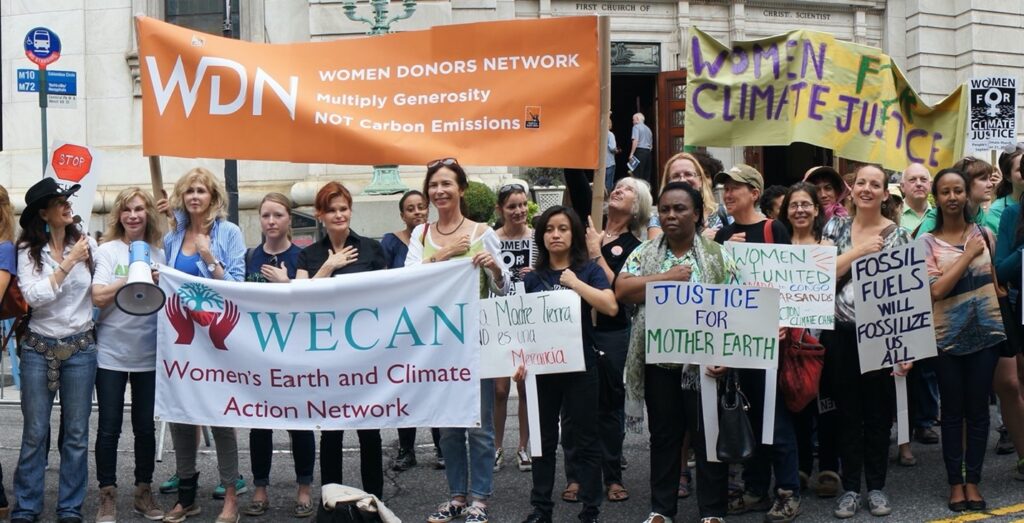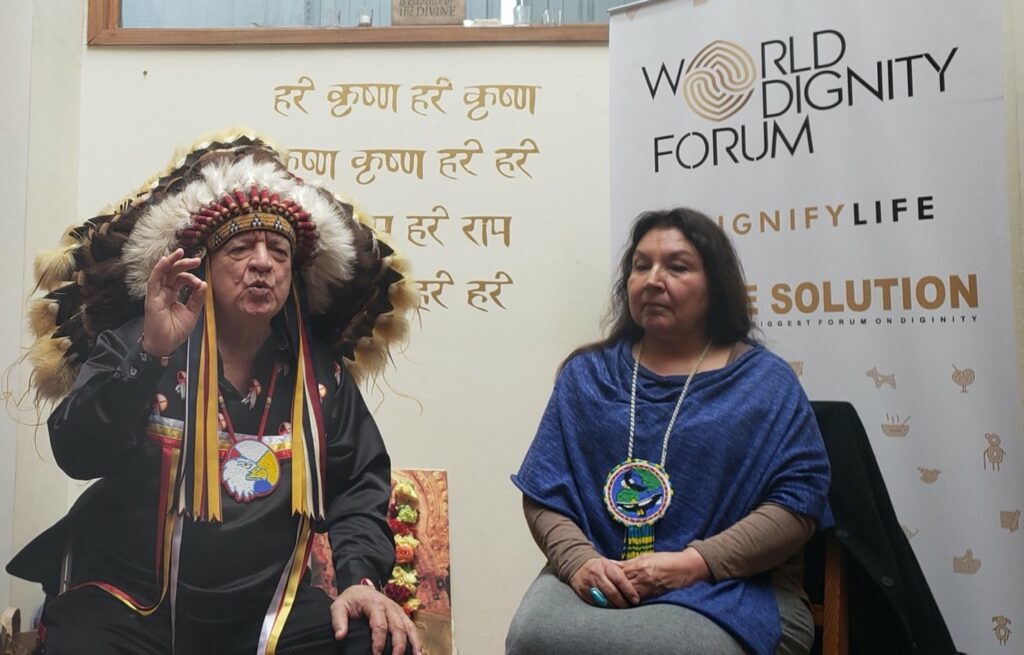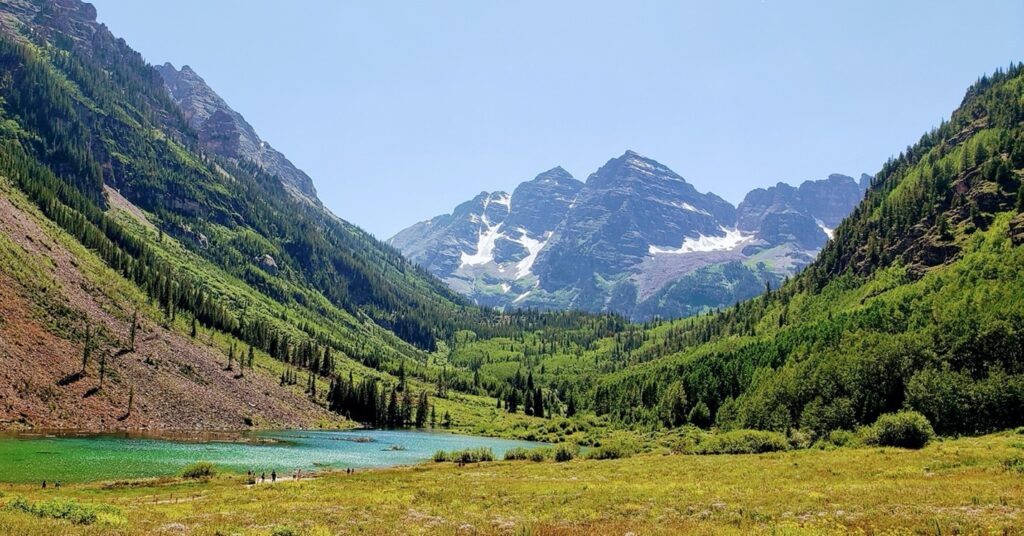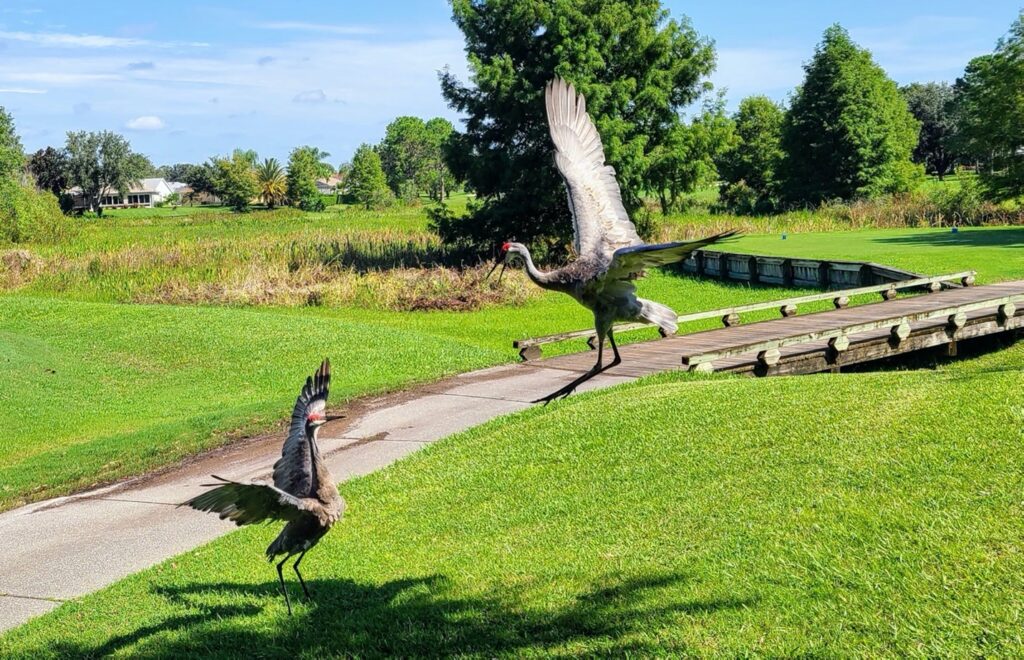Photo: 16’ Tokitai Totem Pole weighing 3000 lbs. carved by the Lummi Nation House of Tears Carvers to bring attention to the captive Lolita Sk’aliCh’elh-tenaut, in the Miami Seaquarium held in inhumane conditions. Janice Hall shown with Phreddie Xwenang Lane(Sul ka dub) and carver Doug Sit Ki Kadem James
With profound respect and passion for indigenous peoples, Janice Hall is a social alchemist who has dedicated a great part of her career to building bridges of understanding and collaboration. Throughout her experiences, she has recognized the importance of integrating nature’s intelligence into everything she does, and that prevention is the key to good health. As founder of Natural Network International, Hall is energized by being involved in some of the work that is shifting us to a regenerative world. Her deep connection to indigenous people and her dream of one humanity thriving together made her the perfect Eco Maven of August! Let’s get to know a little bit more about Janice Hall’s pioneering experience in the Lifestyles of Health and Sustainability industries.
1 . What is your name and occupation?
Janice Hall – founder Natural Network International – business development, trends forecasting, strategic marketing, and brand-building through the lens of a social alchemist – designing and building synergistic culture and business ecosystems. My last name Hall – as a hallway connects rooms, and I connect people and ideas.
2. How did you get involved in health & wellness, environmental sustainability, and clean technology solutions?
This is an expansive question. I am a systems thinker by nature, so when the word holistic came into the lexicon, it was natural for me to approach health in this manner. And then, as my life experiences, interests, and studies unfolded, I had the opportunity to work with all these fields and just naturally saw them as parallel paths that I needed to learn and find the intersections. I am passionate about removing the siloed approach to solving our planetary problems.
Interested in health from my youth, I was a hospital volunteer in my teens. Upon moving from New Jersey to California, I studied herbs and natural medicine modalities such as Chinese, Native American, and Ayurvedic with renowned teachers. I recognized that prevention was the key to good health – and that nature had most of the answers. Dr. Paul Lee, a Philosophy professor from Harvard who founded the Platonic Academy of Herbal Studies, was a mentor. Plato believed the cosmos has a soul because it is a living, breathing being. He taught in his garden, and the center of his garden was an herb garden. Dr. Lee followed suit, but teaching the history of herbs via ancient myth and lore, he threaded the interrelationship and interdependence of nature herself along with science, philosophy, culture and art, thereby enhancing my systems thinking to a cosmological level.
Moving into the business side of ‘natural and organic’ in those early days of the 1970s allowed me to work alongside the historical pioneers of health and wellness supplements, organic foods, regulatory issues, etc. as we laid the ground floor and built the architecture of the natural products industry you see today. Working for New Hope Network, the global natural products communication leader, I worked as Associate Publisher and Director of International Development. At the same time, we built the Natural Products Tradeshows, now boasting over 90,000 visitors from across the world.

I walked 5th Avenue for the first Earth Day in NYC, which totally changed my trajectory. Throughout my business moves for the natural products industry from California to Austin, Pennsylvania, and Boulder, I worked on many local, national, and international environmental issues, including numerous UN projects. My world view was magnified in 1992 when I attended the UN Conference on Environment and Development – aka The Earth Summit in Rio De Janeiro. I helped produce a 5-day Citizen’s Summit there at the Global Forum of NGOs, engaging with key leaders, visionaries, and diverse international cultures and indigenous peoples. Listening to climate scientists also gathered there, I was excited by talk of replacing fossil fuel energy sources, building regenerative agricultural practices, and tackling biodiversity challenges, along with energy-efficient mass transport systems to reduce carbon emissions. I was now hooked on integrating sustainable goals and solutions into everything I did, from my personal life to business life. I learned that a sustainable future world is indeed possible. However, we must incorporate social and environmental concerns and new technologies with ancient indigenous wisdom to save human life on the planet… systems thinking is required again!
3. How has your natural sciences background influenced your vision?
I was interested in the sciences growing up and studied biology, geology, and psychology in college. While living in Princeton, 2009 – 2016, I studied environmental and climate change science and the politics of how the needle is moved. Understanding the earth, its ecosystems, and the cosmological forces that shape our worlds help me see the nature of things and how they fit together. The concepts of biomimicry and cosmomimicry have been essential to me in designing sustainable business practices and systems.
Applying my science background to my marketing expertise helped me understand why formulas worked or not and enabled me to advise companies about their competition. Climate change science helped me with supply chain issues and shape-shifting a company into a sustainable and regenerative one. I can work with scientists and translate their technical science into ‘consumer speak.’ Whether environmental issues, hydrogen technology, or supplements.
4. How has your over 40 years of pioneering experience in the Lifestyles of Health and Sustainability industries, influenced your focus on indigenous peoples?
I think the reverse is actually true. My lifelong interest in health, nature, and indigenous peoples may have been what got me involved in LOHAS. I grew up with National Geographic and two parents who raised me to have deep respect for indigenous peoples. But it was when I went to the Rio Earth Summit and then subsequently worked with John Denver for four years on his Choices for the Future Symposiums, my experience expanded. I listened, drummed, and did ceremonies and sweat lodges with Native Americans and witnessed Native Grandmothers changing the world view of former LA gang members that my colleague brought to Aspen. Since then, I have continued opening ‘hallways’ for non-indigenous and Indigenous to meet and learn from each other.

5. What do you think are the main issues to focus on to better protect indigenous people?
First and foremost, we must listen to them. Dadirri is an Aboriginal word for ‘deep listening.’ My work with them has taught me that they live in the present and in ‘deep time’ where they listen to the wisdom of their ancestors. Remember, we all share the same water from the beginning of time. Lakota say, ‘Mini Wiconi’ – Water is Life. Indigenous peoples KNOW we are all connected – they KNOW we are part of one living system. They incorporate their cultural and spiritual values into every aspect of their life. The ancestral wisdom they hold may be the very key to saving civilization.
According to National Geographic, the world’s 370 million indigenous peoples make up less than 5% of the total human population, yet they manage or hold tenure over 25% of the world’s land surface and support about 80% of the global biodiversity. They are, however, literally dying every day trying to protect their lands and cultures due to human thirst and government greed for their natural resources. For instance, in the ‘race to the rainforest,’ I recognized that the very industry I loved was taking advantage all too often of the bountiful botanicals of the rainforest and not renumerating, respecting, or protecting the lands and culture of the indigenous peoples who tended them for centuries. Therefore, we must be transparent and vigilant about our supply chains – from end to end. I guarantee that indigenous peoples are working somewhere along that chain or their natural resources are involved.
6. The theme of this year’s International Day of the World’s Indigenous Peoples (August 9) was “Leaving No One Behind…” How do you think we can help lift indigenous from a legacy of exclusion and marginalization?
Take the time to study their cultures and the lands they protect. Learn about how they respect the cycles of life – both celestial and terrestrial and synchronize their lives accordingly. Support organizations that support their lives. Here are a few I work with:
- Global Center for Indigenous Sciences and Ancestral Wisdom – Hereditary Chief Phil Lane Jr. https://thecondorandtheeagle.com
- Red Road to DC – Lummi Nation on the Salish Sea campaign to protect sacred tribal lands. https://redroadtodc.org/
- Women’s Earth and Climate Action Network – Climate justice and community-led solutions. https://www.wecaninternational.org/
- Fitzroy River – Dr. Anne Poelina https://www.youtube.com/watch?v=FZmflOQarnM
- Dr. Anita Sanchez https://foursacredgifts.com/
7. What inspires you the most about the work of your company Natural Network International?
The people I get to work with inspire me. It is an exciting time in history, even with some of the dark issues we are facing. I am blessed to be part of the work that is shifting that to a regenerative world. As Bucky Fuller says: “You never change things by fighting the existing reality. To change something, build a new model that makes the existing model obsolete.”
8. Can you share some of the challenges you face in your position?
Dealing with my own impatience and frustration at the world not ‘getting it’ fast enough…. That“it” would be climate change and the wisdom of indigenous peoples to help us forge a healthy path forward.
9. What are your most positive and proud outcomes?
I’m not particularly eager to laud my successes, so I will only say in general that it was rewarding to have been one of the pioneers of the natural and environmental movements. But I mostly take a deep breath of gratitude every time I introduce indigenous peoples to each other and to non-indigenous, enabling a path for building new bridges of understanding and collaboration…. Bringing my dream of one humanity closer by the day.
10. In your experience, how open are company leaders to the pressing measurements needed to meet and combat the climate crisis?
This is a very loaded question and too complex to answer here… but simply said – not open enough and not fast enough. Sadly, many companies still don’t know what to do, many of the small companies don’t have the budget for the necessary changes, and all too often, the large corporations do know, but until we move from the weight of the quarterly bottom line to a more purpose-driven regenerative economy, we won’t see the changes at the speed we need.
11. How should organizations adapt to the new realities of the COVID-19 pandemic?
I don’t believe Covid is the problem. Instead, we must get to the root cause, which in my opinion is greed, overconsumption, and the rape of nature. Instead, we need to work to understand nature, shift the focus to prevention by strengthening our immune systems, and find the natural cures out there.
12. What changes would you like to see in the private and public sector that can positively move the needle towards a healthier and safe planet?
We are all here on one planet – Spaceship Earth, as Bucky Fuller says. We are spinning at 1000 MPH, and don’t fall off! People, in general, need to begin seeing themselves as part of an interdependent whole. The one common ground the whole of humanity shares is literally ‘the ground,’ the earth beneath our feet.
13. What have you learned from the many high-profile positions you have held in your career? And how can our readers apply your experience in their professional growth?
Take a holistic and systems approach to leadership. Nurture talent. Model cooperation and collaboration – not competition. Know your moral compass and stick to it. Find people more intelligent than you to do the things you don’t wish to do. Remember to honor the people you work with, as each person’s role adds value to make the ‘whole’ work. As a leader, share your vision with the whole team. People want to feel a part of something bigger than themselves.
14. Are your outdoor adventures a source of inspiration for the work you do?
It can get very busy inside my head and nature is my best soother and teacher. Her systems become templates for my work and life. My battery becomes recharged, whether watching a meditative, peaceful sunset or becoming one with the mountain while skiing. Observing Her beauty and mastery gives me pause… I remember to let go of my ‘doing’ self and move into my ‘being’ self. The answers lie there…. And sometimes, the answer is no answer, except being present.

15. How do you balance your professional and personal life?
For me, they are one and the same since I only work with people I respect and projects that foster a thrivable world. I will add that my fuel is infusing them both with joy and gratitude.
16. What do you do when you are not working on making impactful and positive changes?
I spend time in nature and with friends. At present I live in Florida, and I ride my bike, take pictures of the magnificent birds and nature, and read the books all my friends are writing! I am a lifelong learner, and this gives me great joy.

17. Who inspires you?
Buckminster Fuller, Barbara Marx Hubbard, Hazel Henderson, Jean Houston, Anneloes Smitsman, Hereditary Chief Phil Lane, Dr. Anne Poelina, Dr. David Bohm, Dr. Sylvia Earle.
18. How would you like to be remembered?
I want to be remembered as a worthy ancestor by future generations.
 Food
Food Farmers
Farmers Sustainable Living
Sustainable Living Living Planet
Living Planet News
News